Analysis of Financial Resources: Planning, Budgeting & Statements
VerifiedAdded on 2024/05/16
|32
|4890
|91
Report
AI Summary
This report provides a detailed analysis of managing financial resources and making informed financial decisions. It begins by examining the advantages and disadvantages of obtaining a listing on the London Stock Exchange, along with the methods for achieving such a listing and raising capital. The report then delves into the calculation of the cost of share capital, the importance of financial planning, and the information needs of different management levels, highlighting the impact of finance on financial statements. Furthermore, it incorporates absorption costing and the creation of financial statements, including project evaluation using various techniques to facilitate sound decision-making. Finally, the report concludes with a ratio analysis and a discussion of the format of financial statements. The document is available on Desklib, where students can find a wealth of past papers and solved assignments.
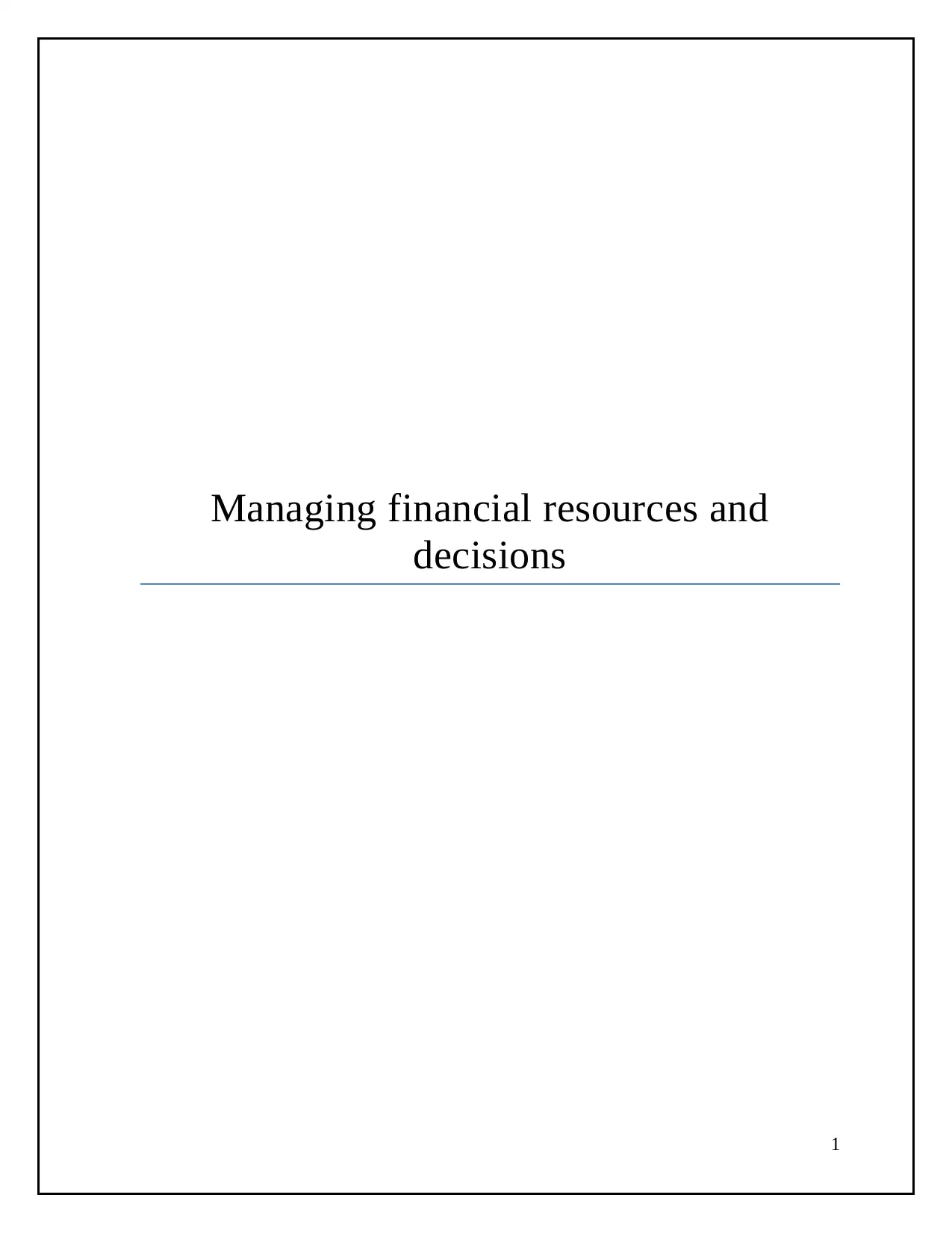
Managing financial resources and
decisions
1
decisions
1
Paraphrase This Document
Need a fresh take? Get an instant paraphrase of this document with our AI Paraphraser
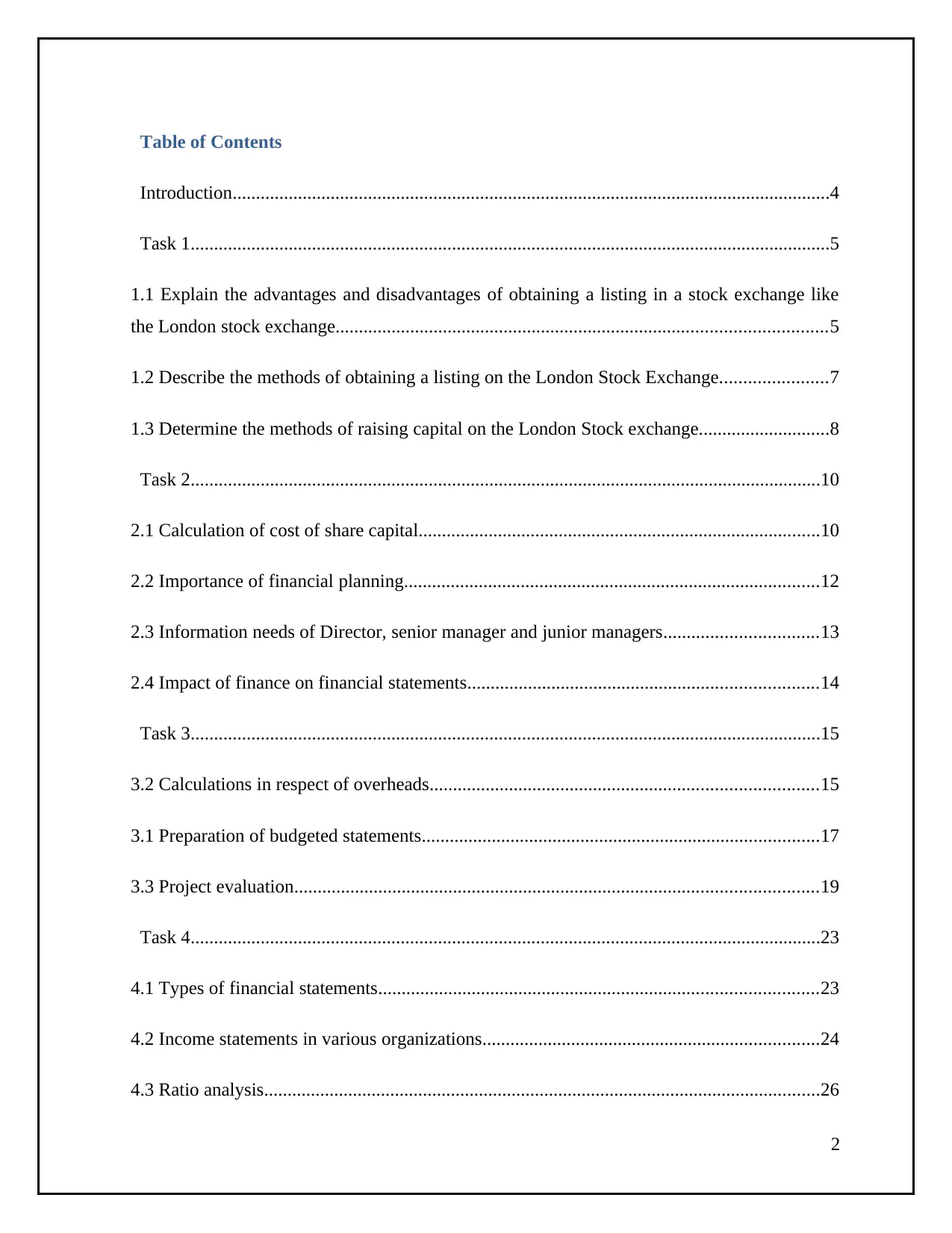
Table of Contents
Introduction................................................................................................................................4
Task 1.........................................................................................................................................5
1.1 Explain the advantages and disadvantages of obtaining a listing in a stock exchange like
the London stock exchange.........................................................................................................5
1.2 Describe the methods of obtaining a listing on the London Stock Exchange.......................7
1.3 Determine the methods of raising capital on the London Stock exchange............................8
Task 2.......................................................................................................................................10
2.1 Calculation of cost of share capital......................................................................................10
2.2 Importance of financial planning.........................................................................................12
2.3 Information needs of Director, senior manager and junior managers.................................13
2.4 Impact of finance on financial statements...........................................................................14
Task 3.......................................................................................................................................15
3.2 Calculations in respect of overheads...................................................................................15
3.1 Preparation of budgeted statements.....................................................................................17
3.3 Project evaluation................................................................................................................19
Task 4.......................................................................................................................................23
4.1 Types of financial statements..............................................................................................23
4.2 Income statements in various organizations........................................................................24
4.3 Ratio analysis.......................................................................................................................26
2
Introduction................................................................................................................................4
Task 1.........................................................................................................................................5
1.1 Explain the advantages and disadvantages of obtaining a listing in a stock exchange like
the London stock exchange.........................................................................................................5
1.2 Describe the methods of obtaining a listing on the London Stock Exchange.......................7
1.3 Determine the methods of raising capital on the London Stock exchange............................8
Task 2.......................................................................................................................................10
2.1 Calculation of cost of share capital......................................................................................10
2.2 Importance of financial planning.........................................................................................12
2.3 Information needs of Director, senior manager and junior managers.................................13
2.4 Impact of finance on financial statements...........................................................................14
Task 3.......................................................................................................................................15
3.2 Calculations in respect of overheads...................................................................................15
3.1 Preparation of budgeted statements.....................................................................................17
3.3 Project evaluation................................................................................................................19
Task 4.......................................................................................................................................23
4.1 Types of financial statements..............................................................................................23
4.2 Income statements in various organizations........................................................................24
4.3 Ratio analysis.......................................................................................................................26
2

Conclusion...............................................................................................................................30
References................................................................................................................................31
3
References................................................................................................................................31
3
⊘ This is a preview!⊘
Do you want full access?
Subscribe today to unlock all pages.

Trusted by 1+ million students worldwide
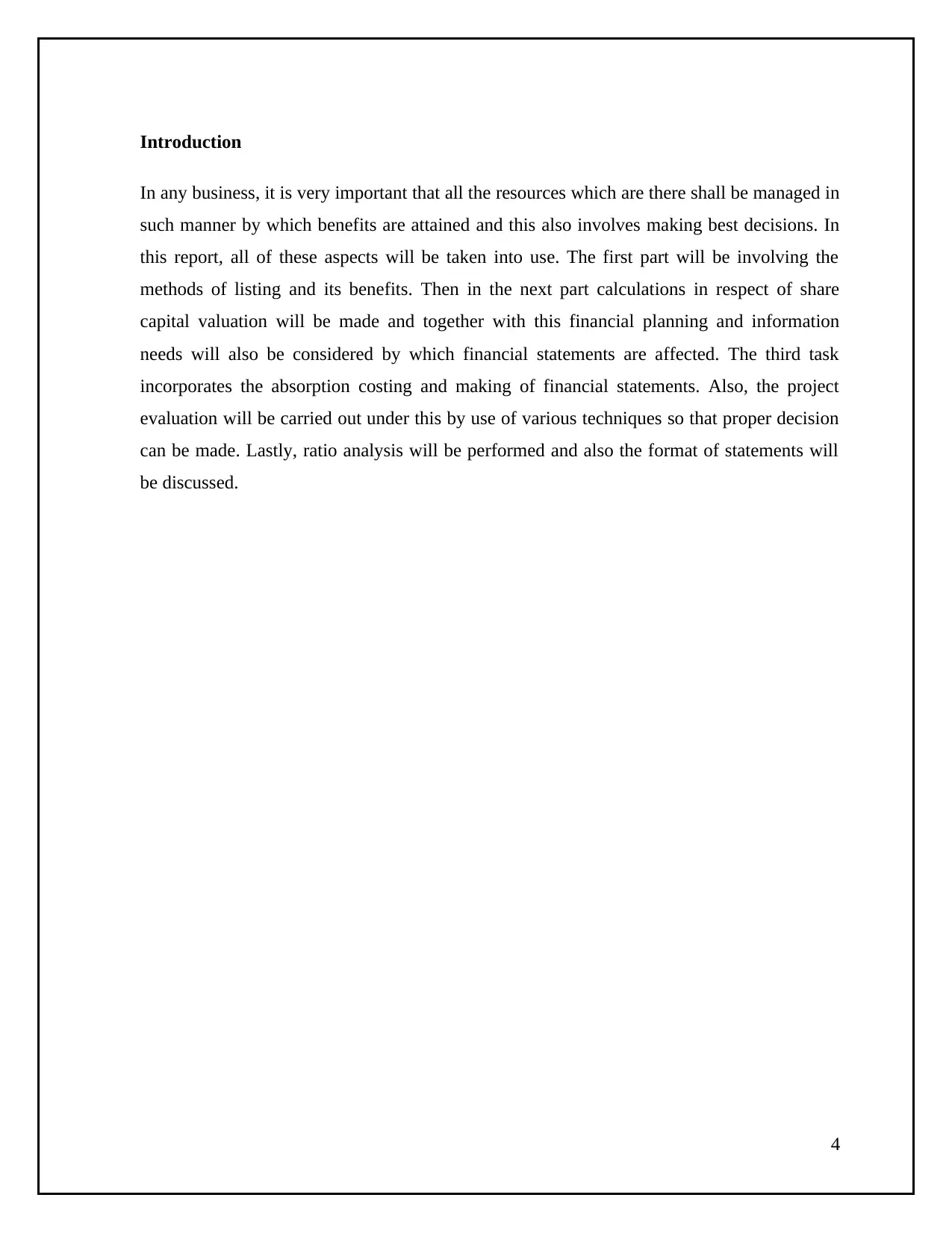
Introduction
In any business, it is very important that all the resources which are there shall be managed in
such manner by which benefits are attained and this also involves making best decisions. In
this report, all of these aspects will be taken into use. The first part will be involving the
methods of listing and its benefits. Then in the next part calculations in respect of share
capital valuation will be made and together with this financial planning and information
needs will also be considered by which financial statements are affected. The third task
incorporates the absorption costing and making of financial statements. Also, the project
evaluation will be carried out under this by use of various techniques so that proper decision
can be made. Lastly, ratio analysis will be performed and also the format of statements will
be discussed.
4
In any business, it is very important that all the resources which are there shall be managed in
such manner by which benefits are attained and this also involves making best decisions. In
this report, all of these aspects will be taken into use. The first part will be involving the
methods of listing and its benefits. Then in the next part calculations in respect of share
capital valuation will be made and together with this financial planning and information
needs will also be considered by which financial statements are affected. The third task
incorporates the absorption costing and making of financial statements. Also, the project
evaluation will be carried out under this by use of various techniques so that proper decision
can be made. Lastly, ratio analysis will be performed and also the format of statements will
be discussed.
4
Paraphrase This Document
Need a fresh take? Get an instant paraphrase of this document with our AI Paraphraser
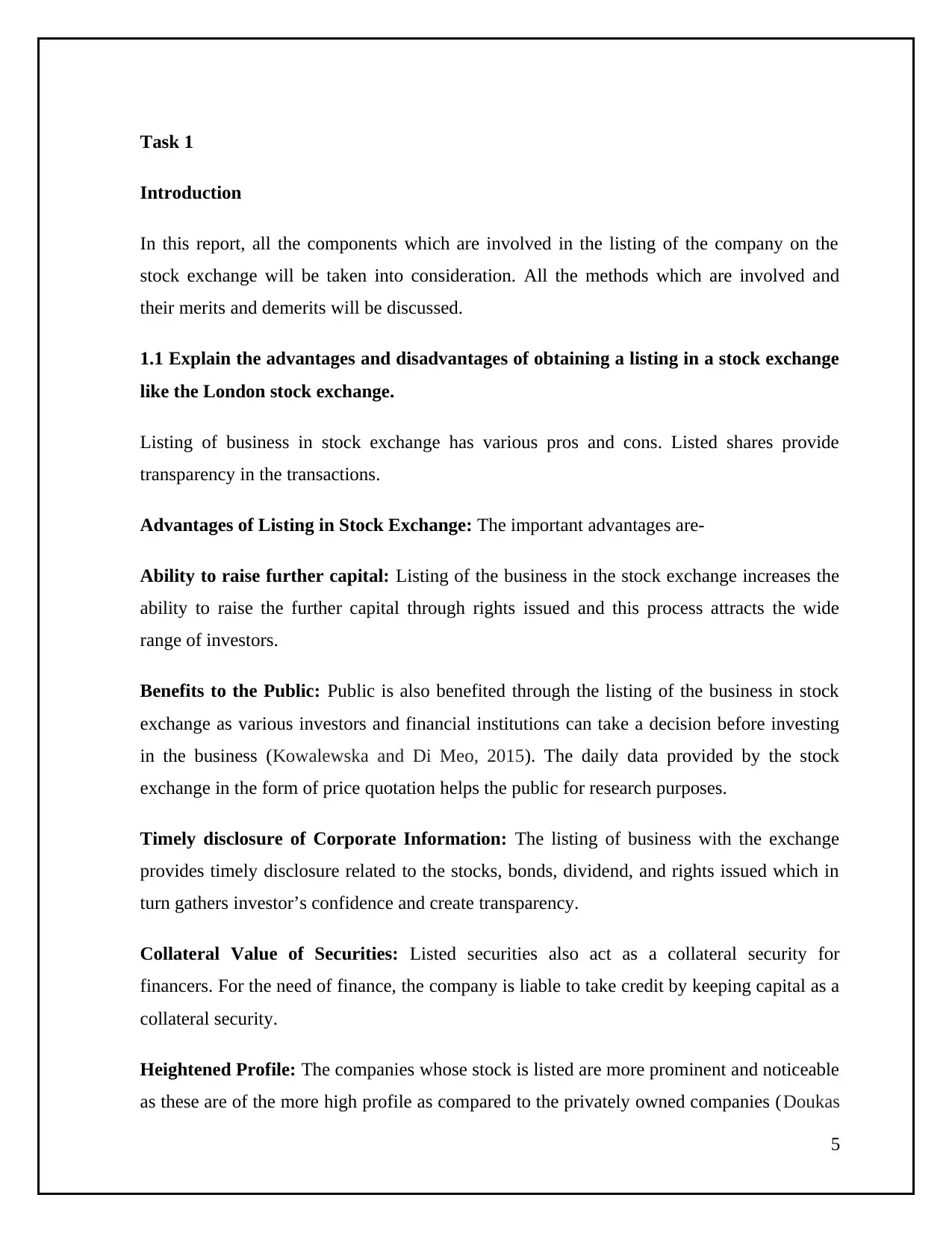
Task 1
Introduction
In this report, all the components which are involved in the listing of the company on the
stock exchange will be taken into consideration. All the methods which are involved and
their merits and demerits will be discussed.
1.1 Explain the advantages and disadvantages of obtaining a listing in a stock exchange
like the London stock exchange.
Listing of business in stock exchange has various pros and cons. Listed shares provide
transparency in the transactions.
Advantages of Listing in Stock Exchange: The important advantages are-
Ability to raise further capital: Listing of the business in the stock exchange increases the
ability to raise the further capital through rights issued and this process attracts the wide
range of investors.
Benefits to the Public: Public is also benefited through the listing of the business in stock
exchange as various investors and financial institutions can take a decision before investing
in the business (Kowalewska and Di Meo, 2015). The daily data provided by the stock
exchange in the form of price quotation helps the public for research purposes.
Timely disclosure of Corporate Information: The listing of business with the exchange
provides timely disclosure related to the stocks, bonds, dividend, and rights issued which in
turn gathers investor’s confidence and create transparency.
Collateral Value of Securities: Listed securities also act as a collateral security for
financers. For the need of finance, the company is liable to take credit by keeping capital as a
collateral security.
Heightened Profile: The companies whose stock is listed are more prominent and noticeable
as these are of the more high profile as compared to the privately owned companies (Doukas
5
Introduction
In this report, all the components which are involved in the listing of the company on the
stock exchange will be taken into consideration. All the methods which are involved and
their merits and demerits will be discussed.
1.1 Explain the advantages and disadvantages of obtaining a listing in a stock exchange
like the London stock exchange.
Listing of business in stock exchange has various pros and cons. Listed shares provide
transparency in the transactions.
Advantages of Listing in Stock Exchange: The important advantages are-
Ability to raise further capital: Listing of the business in the stock exchange increases the
ability to raise the further capital through rights issued and this process attracts the wide
range of investors.
Benefits to the Public: Public is also benefited through the listing of the business in stock
exchange as various investors and financial institutions can take a decision before investing
in the business (Kowalewska and Di Meo, 2015). The daily data provided by the stock
exchange in the form of price quotation helps the public for research purposes.
Timely disclosure of Corporate Information: The listing of business with the exchange
provides timely disclosure related to the stocks, bonds, dividend, and rights issued which in
turn gathers investor’s confidence and create transparency.
Collateral Value of Securities: Listed securities also act as a collateral security for
financers. For the need of finance, the company is liable to take credit by keeping capital as a
collateral security.
Heightened Profile: The companies whose stock is listed are more prominent and noticeable
as these are of the more high profile as compared to the privately owned companies (Doukas
5
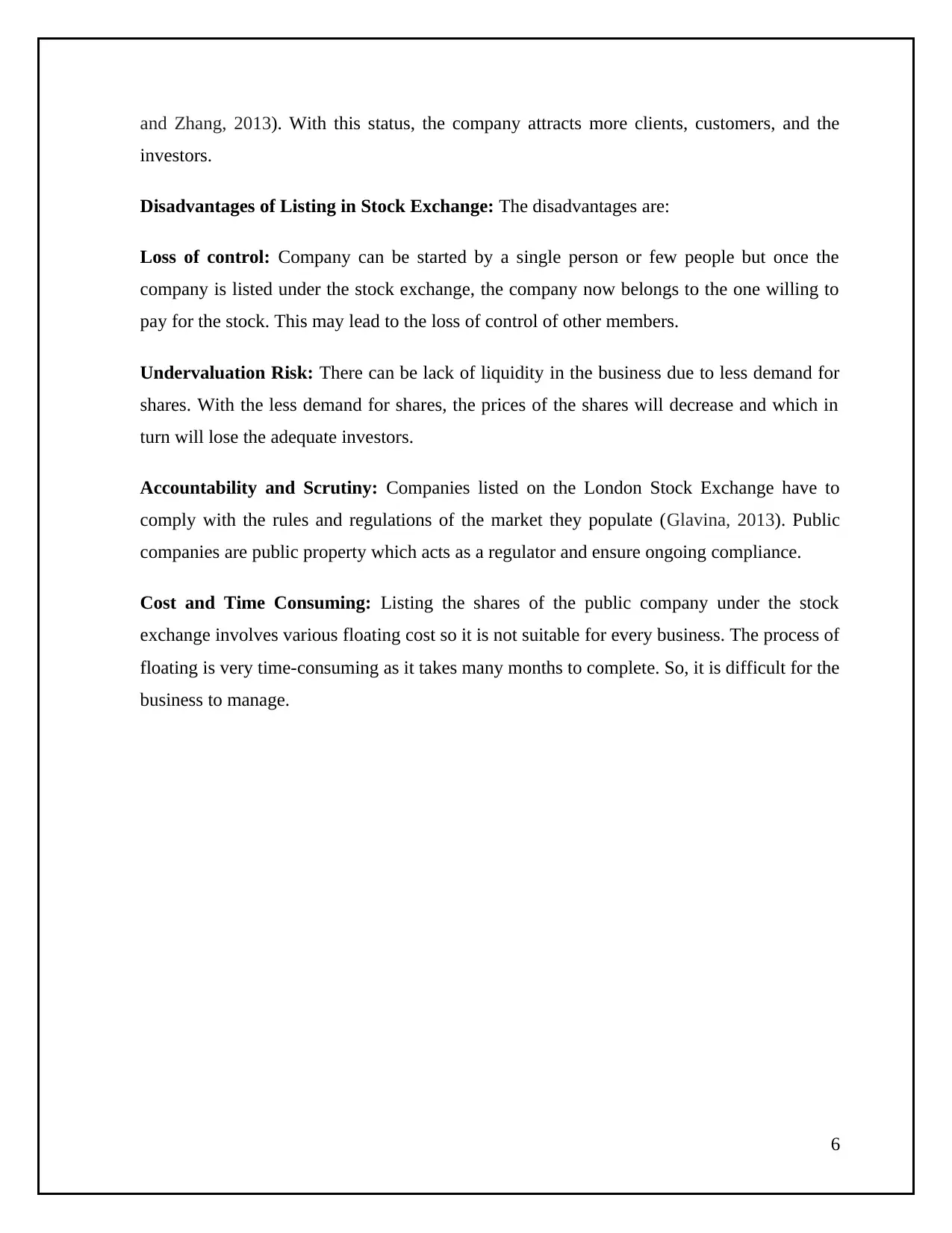
and Zhang, 2013). With this status, the company attracts more clients, customers, and the
investors.
Disadvantages of Listing in Stock Exchange: The disadvantages are:
Loss of control: Company can be started by a single person or few people but once the
company is listed under the stock exchange, the company now belongs to the one willing to
pay for the stock. This may lead to the loss of control of other members.
Undervaluation Risk: There can be lack of liquidity in the business due to less demand for
shares. With the less demand for shares, the prices of the shares will decrease and which in
turn will lose the adequate investors.
Accountability and Scrutiny: Companies listed on the London Stock Exchange have to
comply with the rules and regulations of the market they populate (Glavina, 2013). Public
companies are public property which acts as a regulator and ensure ongoing compliance.
Cost and Time Consuming: Listing the shares of the public company under the stock
exchange involves various floating cost so it is not suitable for every business. The process of
floating is very time-consuming as it takes many months to complete. So, it is difficult for the
business to manage.
6
investors.
Disadvantages of Listing in Stock Exchange: The disadvantages are:
Loss of control: Company can be started by a single person or few people but once the
company is listed under the stock exchange, the company now belongs to the one willing to
pay for the stock. This may lead to the loss of control of other members.
Undervaluation Risk: There can be lack of liquidity in the business due to less demand for
shares. With the less demand for shares, the prices of the shares will decrease and which in
turn will lose the adequate investors.
Accountability and Scrutiny: Companies listed on the London Stock Exchange have to
comply with the rules and regulations of the market they populate (Glavina, 2013). Public
companies are public property which acts as a regulator and ensure ongoing compliance.
Cost and Time Consuming: Listing the shares of the public company under the stock
exchange involves various floating cost so it is not suitable for every business. The process of
floating is very time-consuming as it takes many months to complete. So, it is difficult for the
business to manage.
6
⊘ This is a preview!⊘
Do you want full access?
Subscribe today to unlock all pages.

Trusted by 1+ million students worldwide
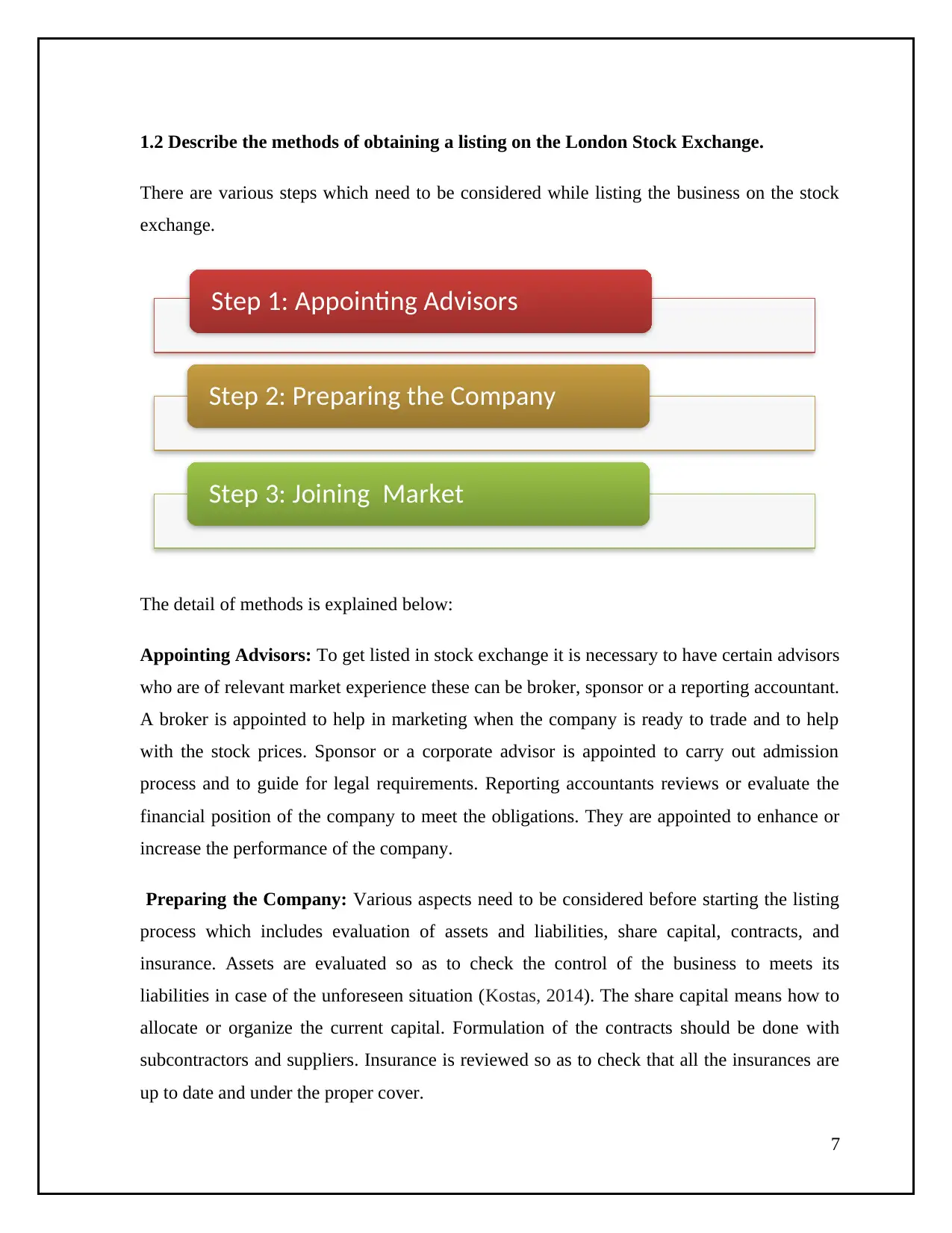
1.2 Describe the methods of obtaining a listing on the London Stock Exchange.
There are various steps which need to be considered while listing the business on the stock
exchange.
The detail of methods is explained below:
Appointing Advisors: To get listed in stock exchange it is necessary to have certain advisors
who are of relevant market experience these can be broker, sponsor or a reporting accountant.
A broker is appointed to help in marketing when the company is ready to trade and to help
with the stock prices. Sponsor or a corporate advisor is appointed to carry out admission
process and to guide for legal requirements. Reporting accountants reviews or evaluate the
financial position of the company to meet the obligations. They are appointed to enhance or
increase the performance of the company.
Preparing the Company: Various aspects need to be considered before starting the listing
process which includes evaluation of assets and liabilities, share capital, contracts, and
insurance. Assets are evaluated so as to check the control of the business to meets its
liabilities in case of the unforeseen situation (Kostas, 2014). The share capital means how to
allocate or organize the current capital. Formulation of the contracts should be done with
subcontractors and suppliers. Insurance is reviewed so as to check that all the insurances are
up to date and under the proper cover.
7
Step 1: Appointing Advisors
Step 2: Preparing the Company
Step 3: Joining Market
There are various steps which need to be considered while listing the business on the stock
exchange.
The detail of methods is explained below:
Appointing Advisors: To get listed in stock exchange it is necessary to have certain advisors
who are of relevant market experience these can be broker, sponsor or a reporting accountant.
A broker is appointed to help in marketing when the company is ready to trade and to help
with the stock prices. Sponsor or a corporate advisor is appointed to carry out admission
process and to guide for legal requirements. Reporting accountants reviews or evaluate the
financial position of the company to meet the obligations. They are appointed to enhance or
increase the performance of the company.
Preparing the Company: Various aspects need to be considered before starting the listing
process which includes evaluation of assets and liabilities, share capital, contracts, and
insurance. Assets are evaluated so as to check the control of the business to meets its
liabilities in case of the unforeseen situation (Kostas, 2014). The share capital means how to
allocate or organize the current capital. Formulation of the contracts should be done with
subcontractors and suppliers. Insurance is reviewed so as to check that all the insurances are
up to date and under the proper cover.
7
Step 1: Appointing Advisors
Step 2: Preparing the Company
Step 3: Joining Market
Paraphrase This Document
Need a fresh take? Get an instant paraphrase of this document with our AI Paraphraser
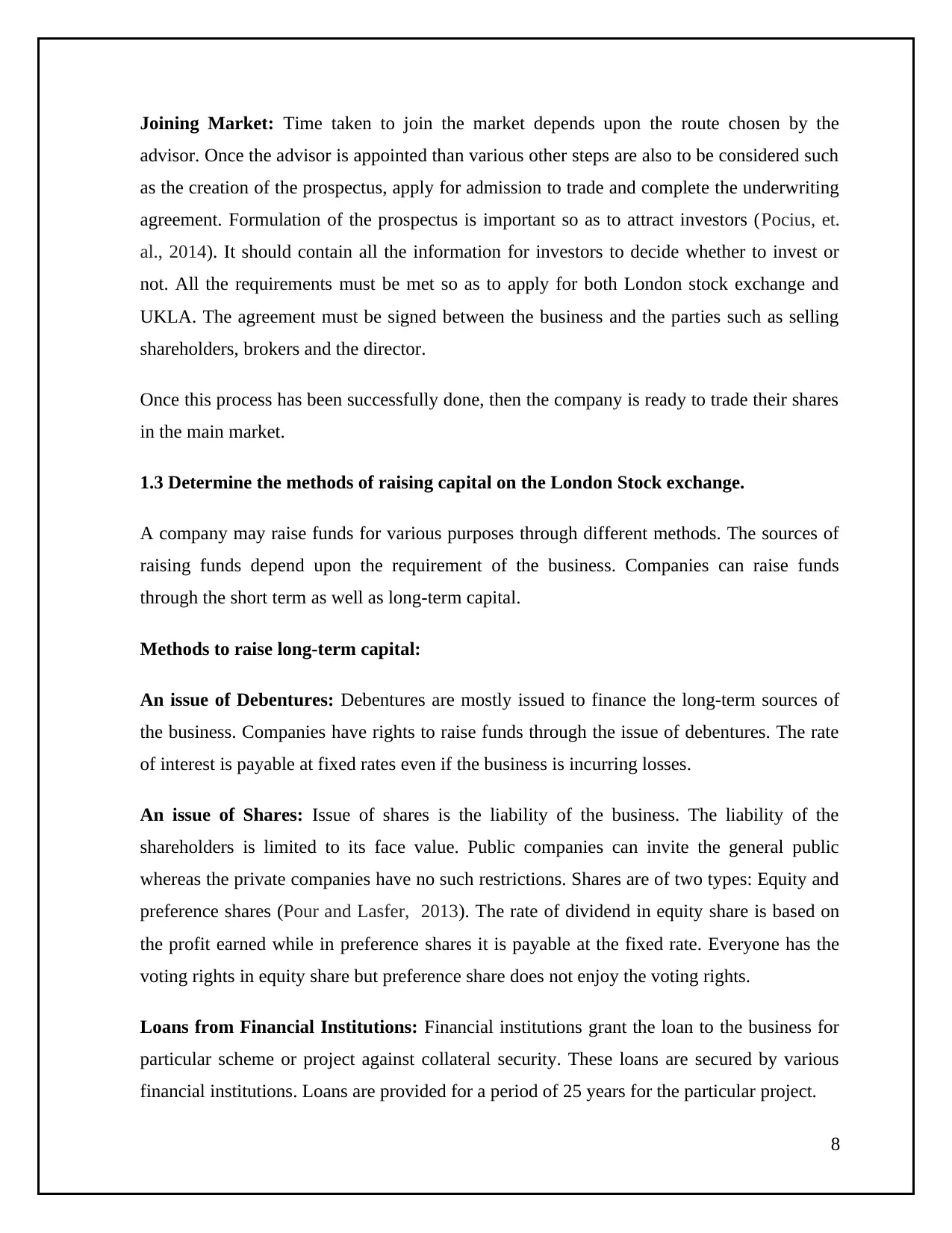
Joining Market: Time taken to join the market depends upon the route chosen by the
advisor. Once the advisor is appointed than various other steps are also to be considered such
as the creation of the prospectus, apply for admission to trade and complete the underwriting
agreement. Formulation of the prospectus is important so as to attract investors (Pocius, et.
al., 2014). It should contain all the information for investors to decide whether to invest or
not. All the requirements must be met so as to apply for both London stock exchange and
UKLA. The agreement must be signed between the business and the parties such as selling
shareholders, brokers and the director.
Once this process has been successfully done, then the company is ready to trade their shares
in the main market.
1.3 Determine the methods of raising capital on the London Stock exchange.
A company may raise funds for various purposes through different methods. The sources of
raising funds depend upon the requirement of the business. Companies can raise funds
through the short term as well as long-term capital.
Methods to raise long-term capital:
An issue of Debentures: Debentures are mostly issued to finance the long-term sources of
the business. Companies have rights to raise funds through the issue of debentures. The rate
of interest is payable at fixed rates even if the business is incurring losses.
An issue of Shares: Issue of shares is the liability of the business. The liability of the
shareholders is limited to its face value. Public companies can invite the general public
whereas the private companies have no such restrictions. Shares are of two types: Equity and
preference shares (Pour and Lasfer, 2013). The rate of dividend in equity share is based on
the profit earned while in preference shares it is payable at the fixed rate. Everyone has the
voting rights in equity share but preference share does not enjoy the voting rights.
Loans from Financial Institutions: Financial institutions grant the loan to the business for
particular scheme or project against collateral security. These loans are secured by various
financial institutions. Loans are provided for a period of 25 years for the particular project.
8
advisor. Once the advisor is appointed than various other steps are also to be considered such
as the creation of the prospectus, apply for admission to trade and complete the underwriting
agreement. Formulation of the prospectus is important so as to attract investors (Pocius, et.
al., 2014). It should contain all the information for investors to decide whether to invest or
not. All the requirements must be met so as to apply for both London stock exchange and
UKLA. The agreement must be signed between the business and the parties such as selling
shareholders, brokers and the director.
Once this process has been successfully done, then the company is ready to trade their shares
in the main market.
1.3 Determine the methods of raising capital on the London Stock exchange.
A company may raise funds for various purposes through different methods. The sources of
raising funds depend upon the requirement of the business. Companies can raise funds
through the short term as well as long-term capital.
Methods to raise long-term capital:
An issue of Debentures: Debentures are mostly issued to finance the long-term sources of
the business. Companies have rights to raise funds through the issue of debentures. The rate
of interest is payable at fixed rates even if the business is incurring losses.
An issue of Shares: Issue of shares is the liability of the business. The liability of the
shareholders is limited to its face value. Public companies can invite the general public
whereas the private companies have no such restrictions. Shares are of two types: Equity and
preference shares (Pour and Lasfer, 2013). The rate of dividend in equity share is based on
the profit earned while in preference shares it is payable at the fixed rate. Everyone has the
voting rights in equity share but preference share does not enjoy the voting rights.
Loans from Financial Institutions: Financial institutions grant the loan to the business for
particular scheme or project against collateral security. These loans are secured by various
financial institutions. Loans are provided for a period of 25 years for the particular project.
8
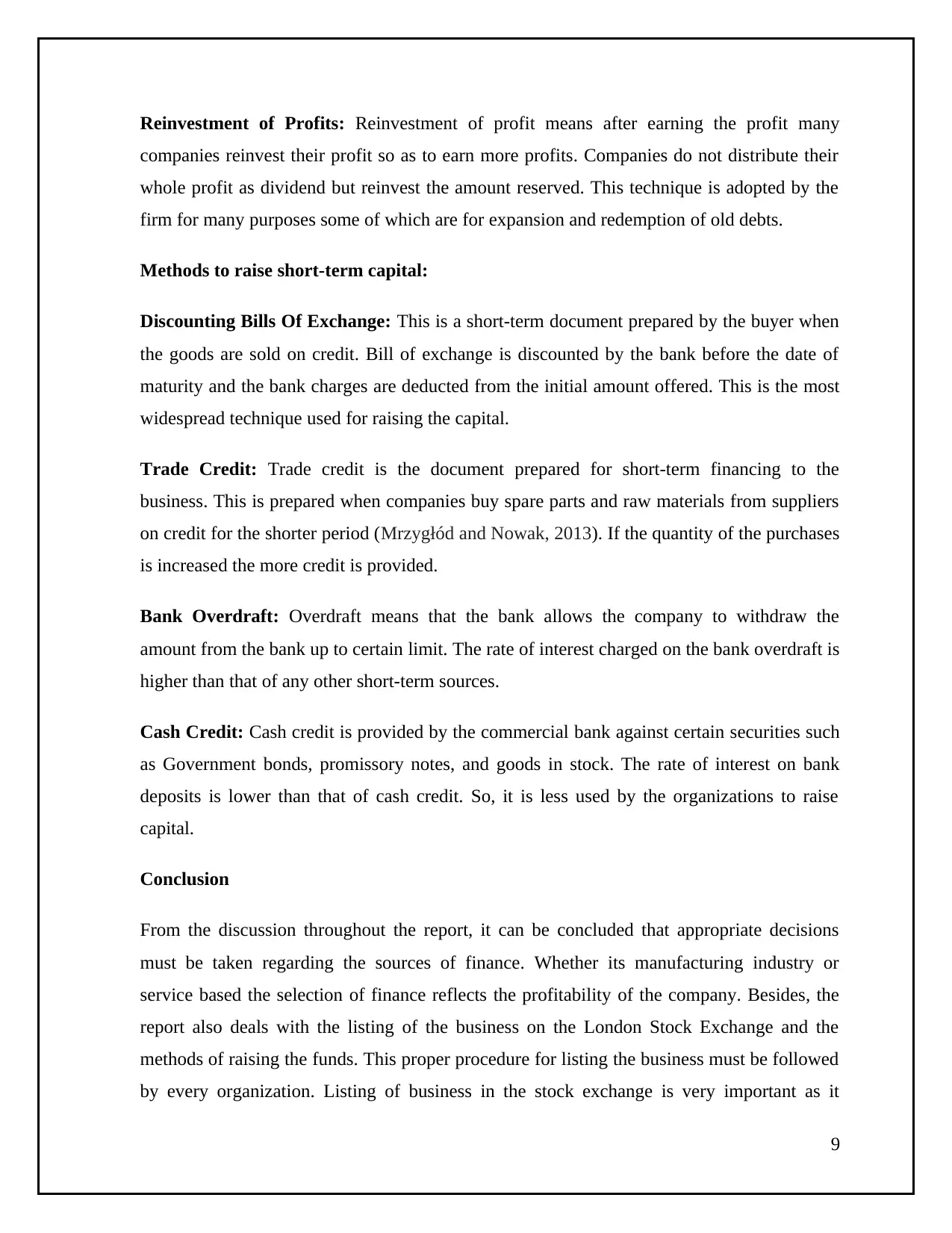
Reinvestment of Profits: Reinvestment of profit means after earning the profit many
companies reinvest their profit so as to earn more profits. Companies do not distribute their
whole profit as dividend but reinvest the amount reserved. This technique is adopted by the
firm for many purposes some of which are for expansion and redemption of old debts.
Methods to raise short-term capital:
Discounting Bills Of Exchange: This is a short-term document prepared by the buyer when
the goods are sold on credit. Bill of exchange is discounted by the bank before the date of
maturity and the bank charges are deducted from the initial amount offered. This is the most
widespread technique used for raising the capital.
Trade Credit: Trade credit is the document prepared for short-term financing to the
business. This is prepared when companies buy spare parts and raw materials from suppliers
on credit for the shorter period (Mrzygłód and Nowak, 2013). If the quantity of the purchases
is increased the more credit is provided.
Bank Overdraft: Overdraft means that the bank allows the company to withdraw the
amount from the bank up to certain limit. The rate of interest charged on the bank overdraft is
higher than that of any other short-term sources.
Cash Credit: Cash credit is provided by the commercial bank against certain securities such
as Government bonds, promissory notes, and goods in stock. The rate of interest on bank
deposits is lower than that of cash credit. So, it is less used by the organizations to raise
capital.
Conclusion
From the discussion throughout the report, it can be concluded that appropriate decisions
must be taken regarding the sources of finance. Whether its manufacturing industry or
service based the selection of finance reflects the profitability of the company. Besides, the
report also deals with the listing of the business on the London Stock Exchange and the
methods of raising the funds. This proper procedure for listing the business must be followed
by every organization. Listing of business in the stock exchange is very important as it
9
companies reinvest their profit so as to earn more profits. Companies do not distribute their
whole profit as dividend but reinvest the amount reserved. This technique is adopted by the
firm for many purposes some of which are for expansion and redemption of old debts.
Methods to raise short-term capital:
Discounting Bills Of Exchange: This is a short-term document prepared by the buyer when
the goods are sold on credit. Bill of exchange is discounted by the bank before the date of
maturity and the bank charges are deducted from the initial amount offered. This is the most
widespread technique used for raising the capital.
Trade Credit: Trade credit is the document prepared for short-term financing to the
business. This is prepared when companies buy spare parts and raw materials from suppliers
on credit for the shorter period (Mrzygłód and Nowak, 2013). If the quantity of the purchases
is increased the more credit is provided.
Bank Overdraft: Overdraft means that the bank allows the company to withdraw the
amount from the bank up to certain limit. The rate of interest charged on the bank overdraft is
higher than that of any other short-term sources.
Cash Credit: Cash credit is provided by the commercial bank against certain securities such
as Government bonds, promissory notes, and goods in stock. The rate of interest on bank
deposits is lower than that of cash credit. So, it is less used by the organizations to raise
capital.
Conclusion
From the discussion throughout the report, it can be concluded that appropriate decisions
must be taken regarding the sources of finance. Whether its manufacturing industry or
service based the selection of finance reflects the profitability of the company. Besides, the
report also deals with the listing of the business on the London Stock Exchange and the
methods of raising the funds. This proper procedure for listing the business must be followed
by every organization. Listing of business in the stock exchange is very important as it
9
⊘ This is a preview!⊘
Do you want full access?
Subscribe today to unlock all pages.

Trusted by 1+ million students worldwide
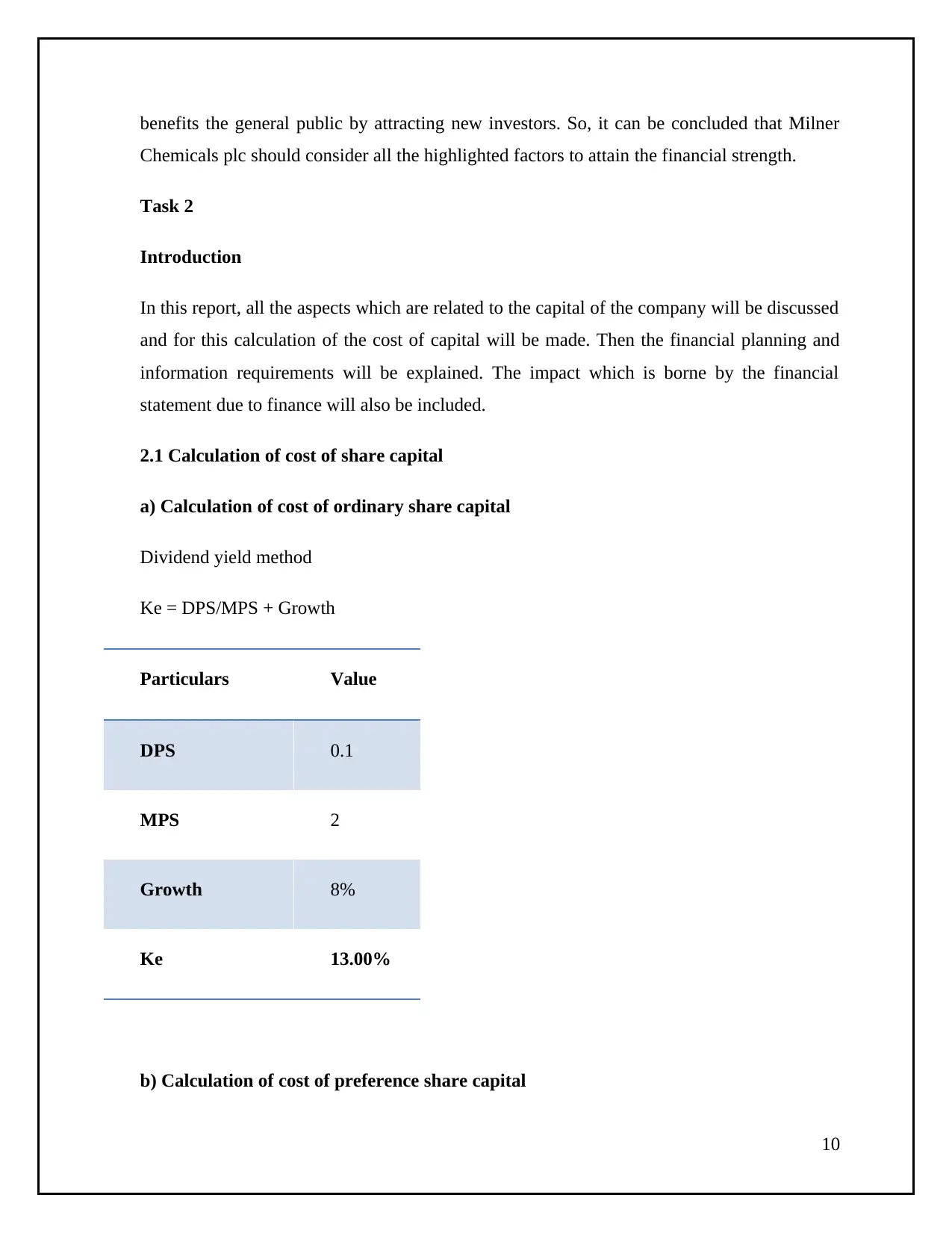
benefits the general public by attracting new investors. So, it can be concluded that Milner
Chemicals plc should consider all the highlighted factors to attain the financial strength.
Task 2
Introduction
In this report, all the aspects which are related to the capital of the company will be discussed
and for this calculation of the cost of capital will be made. Then the financial planning and
information requirements will be explained. The impact which is borne by the financial
statement due to finance will also be included.
2.1 Calculation of cost of share capital
a) Calculation of cost of ordinary share capital
Dividend yield method
Ke = DPS/MPS + Growth
Particulars Value
DPS 0.1
MPS 2
Growth 8%
Ke 13.00%
b) Calculation of cost of preference share capital
10
Chemicals plc should consider all the highlighted factors to attain the financial strength.
Task 2
Introduction
In this report, all the aspects which are related to the capital of the company will be discussed
and for this calculation of the cost of capital will be made. Then the financial planning and
information requirements will be explained. The impact which is borne by the financial
statement due to finance will also be included.
2.1 Calculation of cost of share capital
a) Calculation of cost of ordinary share capital
Dividend yield method
Ke = DPS/MPS + Growth
Particulars Value
DPS 0.1
MPS 2
Growth 8%
Ke 13.00%
b) Calculation of cost of preference share capital
10
Paraphrase This Document
Need a fresh take? Get an instant paraphrase of this document with our AI Paraphraser
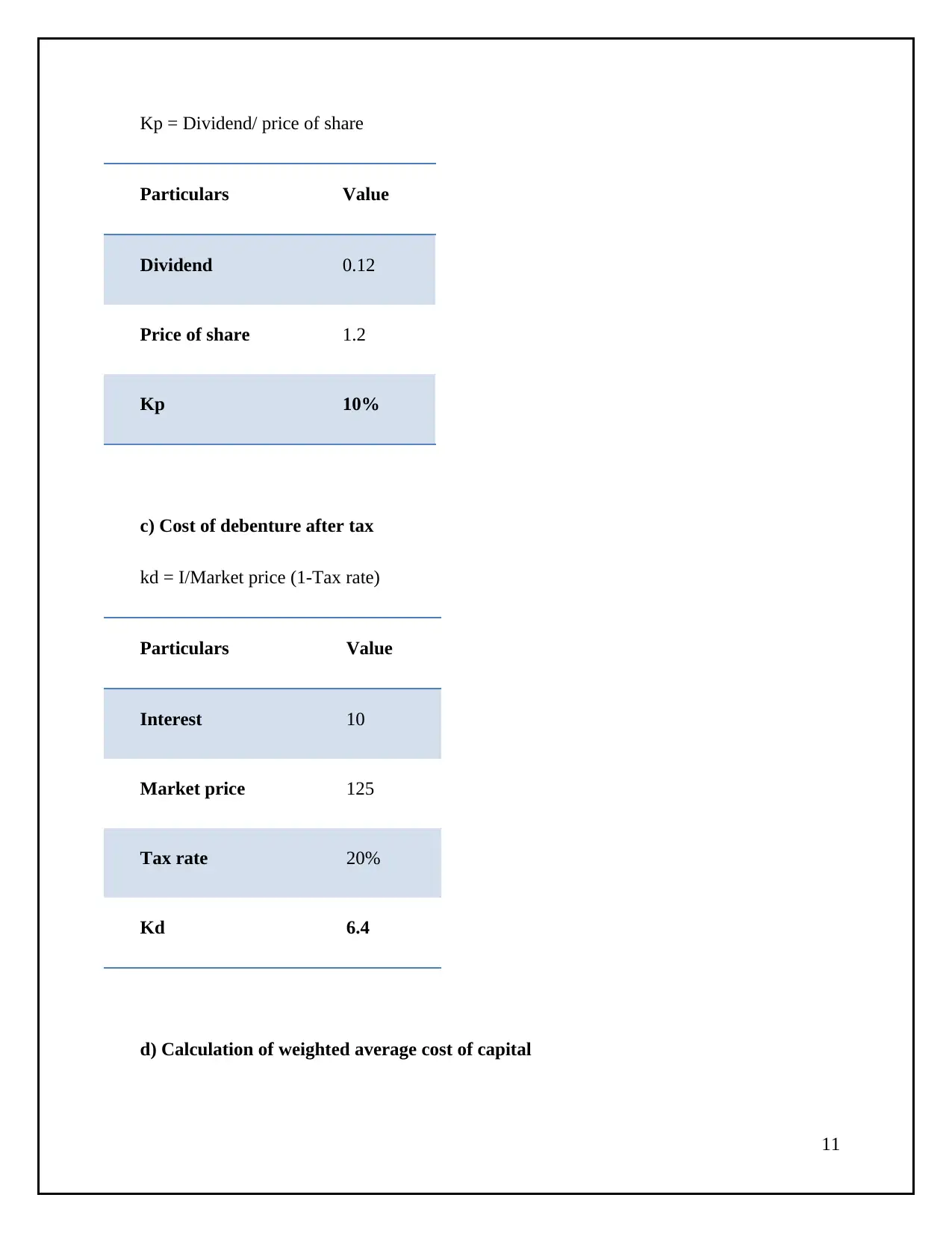
Kp = Dividend/ price of share
Particulars Value
Dividend 0.12
Price of share 1.2
Kp 10%
c) Cost of debenture after tax
kd = I/Market price (1-Tax rate)
Particulars Value
Interest 10
Market price 125
Tax rate 20%
Kd 6.4
d) Calculation of weighted average cost of capital
11
Particulars Value
Dividend 0.12
Price of share 1.2
Kp 10%
c) Cost of debenture after tax
kd = I/Market price (1-Tax rate)
Particulars Value
Interest 10
Market price 125
Tax rate 20%
Kd 6.4
d) Calculation of weighted average cost of capital
11
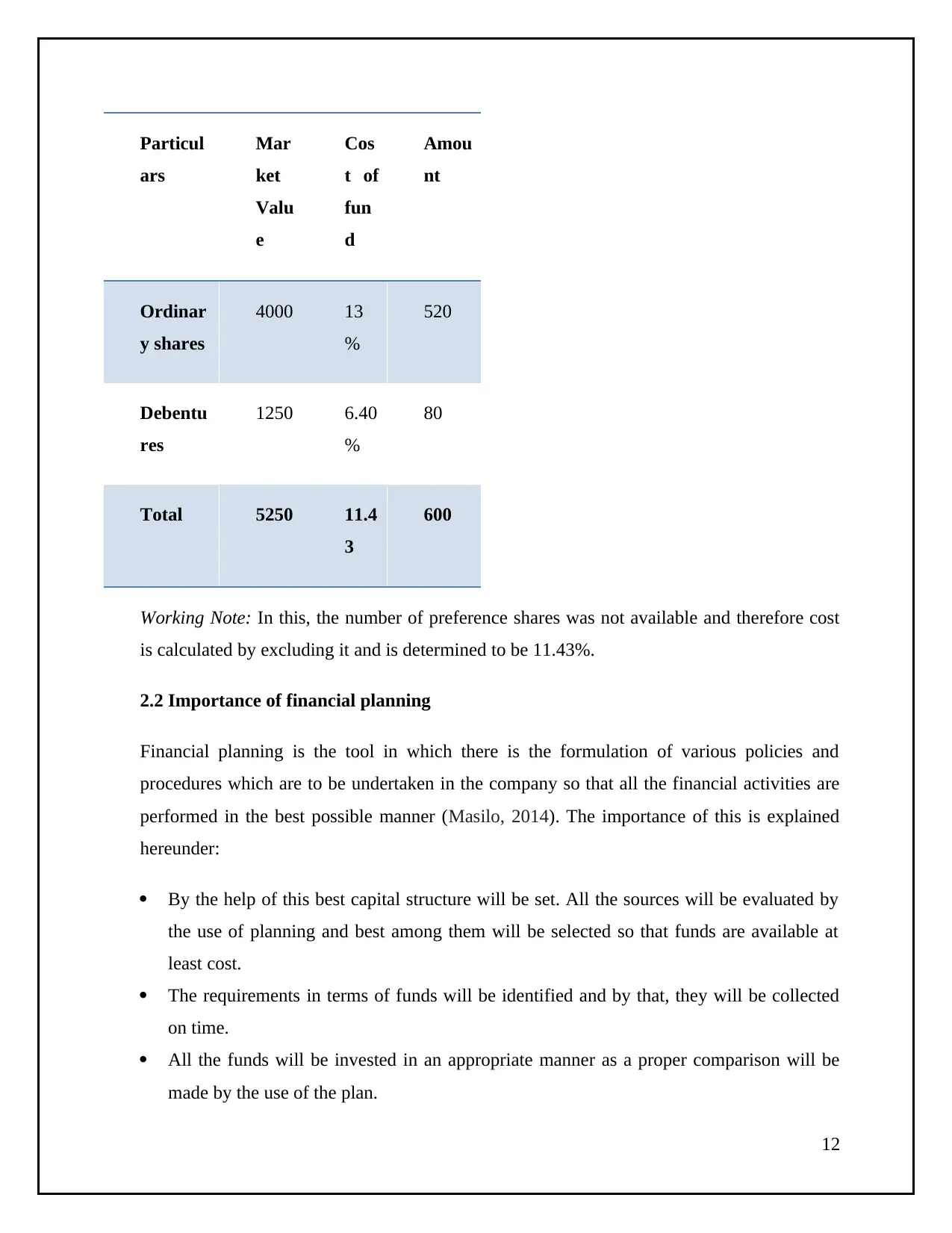
Particul
ars
Mar
ket
Valu
e
Cos
t of
fun
d
Amou
nt
Ordinar
y shares
4000 13
%
520
Debentu
res
1250 6.40
%
80
Total 5250 11.4
3
600
Working Note: In this, the number of preference shares was not available and therefore cost
is calculated by excluding it and is determined to be 11.43%.
2.2 Importance of financial planning
Financial planning is the tool in which there is the formulation of various policies and
procedures which are to be undertaken in the company so that all the financial activities are
performed in the best possible manner (Masilo, 2014). The importance of this is explained
hereunder:
By the help of this best capital structure will be set. All the sources will be evaluated by
the use of planning and best among them will be selected so that funds are available at
least cost.
The requirements in terms of funds will be identified and by that, they will be collected
on time.
All the funds will be invested in an appropriate manner as a proper comparison will be
made by the use of the plan.
12
ars
Mar
ket
Valu
e
Cos
t of
fun
d
Amou
nt
Ordinar
y shares
4000 13
%
520
Debentu
res
1250 6.40
%
80
Total 5250 11.4
3
600
Working Note: In this, the number of preference shares was not available and therefore cost
is calculated by excluding it and is determined to be 11.43%.
2.2 Importance of financial planning
Financial planning is the tool in which there is the formulation of various policies and
procedures which are to be undertaken in the company so that all the financial activities are
performed in the best possible manner (Masilo, 2014). The importance of this is explained
hereunder:
By the help of this best capital structure will be set. All the sources will be evaluated by
the use of planning and best among them will be selected so that funds are available at
least cost.
The requirements in terms of funds will be identified and by that, they will be collected
on time.
All the funds will be invested in an appropriate manner as a proper comparison will be
made by the use of the plan.
12
⊘ This is a preview!⊘
Do you want full access?
Subscribe today to unlock all pages.

Trusted by 1+ million students worldwide
1 out of 32
Related Documents
Your All-in-One AI-Powered Toolkit for Academic Success.
+13062052269
info@desklib.com
Available 24*7 on WhatsApp / Email
![[object Object]](/_next/static/media/star-bottom.7253800d.svg)
Unlock your academic potential
Copyright © 2020–2025 A2Z Services. All Rights Reserved. Developed and managed by ZUCOL.





